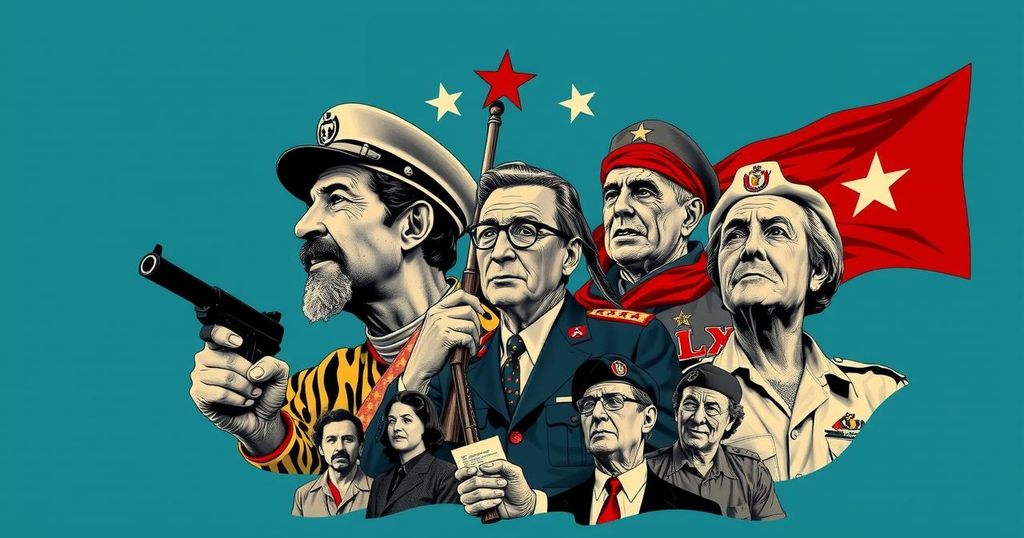Cuba’s Revolutionary Journey: From Socialism to Soviet Support
The article outlines Cuba’s transition to socialism under Fidel Castro, highlighting its dependence on Soviet support, the Cuban Missile Crisis, mass emigration, failed economic reforms, and entrenched isolation from international allies. It examines Cuba’s role in supporting revolutionary movements abroad, the impact of U.S. relations and military actions, and the implications of Soviet aid during the Cold War.
Cuba experienced a tumultuous transition towards socialism, heavily influenced by its deepening reliance on the Soviet Union, which created rifts within both the government and society. This period saw a significant outflow of Cubans, particularly skilled workers and affluent investors, to destinations such as the United States, primarily Miami, and other nations including Spain. The initial years of Fidel Castro’s administration were marked by essential economic and military assistance from the Soviet Union, which also incited vehement opposition from the United States, notably highlighted during the Cuban Missile Crisis in October 1962. This critical standoff arose following the installation of Soviet nuclear missiles in Cuba, prompting the United States to impose a naval blockade as tensions escalated toward the brink of war. As Cuba grappled with significant shortages of food, fuel, and essential commodities, the government enacted a second agrarian reform in the mid-1960s that further entrenched its dependence on the sugarcane industry. Concurrently, Cuba sought to export its revolutionary fervor, hosting a conference of Latin American Marxists in Havana in 1964 and influencing civil strife in the Dominican Republic, leading to U.S. military intervention in 1965. The revolutionary figure Che Guevara engaged in underground activities in Congo and ultimately lost his life in 1967 while attempting to incite a revolution in Bolivia. As a result of these efforts to incite unrest, Cuba increasingly became isolated from many Latin American and Caribbean nations. The late 1960s saw renewed governmental efforts to suppress private enterprise, with the nationalization of hundreds of small businesses. Military personnel ascended to prominent positions within government and the Communist Party, while the regime pursued strategies to enhance production through moral incentives and labor mobilization. However, when these measures proved ineffective, Cuba reverted to a centrally planned Soviet-style economic model. In 1976, a new constitution and electoral code were enacted, consolidating Castro’s power as both the President of the Council of Ministers and the Council of State, effectively merging presidential and prime ministerial duties. The 1970s witnessed slight material improvements, as the country began addressing various shortages and bottlenecks. Diplomatic isolation waned as Cuba took on a more prominent role among developing and non-aligned nations, asserting itself particularly in Africa and Latin America. Nonetheless, Cuba’s support for the Soviet invasion of Afghanistan in 1979 strained relations with non-aligned countries and elicited U.S. discontent regarding the presence of Soviet troops in Cuba. The 1980s were marked by Cuban military involvement in civil conflicts across Angola and Ethiopia, while significant geopolitical challenges appeared, such as the U.S. invasion of Grenada in 1983, which resulted in Cuban casualties and the expulsion of Cuban forces from the island. Despite some thawing in Cuba-U.S. relations post-revolution, the enduring U.S. trade embargo established in the early 1960s remained generally unaltered. Provocative U.S. actions, including the Grenadian invasion and continued scrutiny of political repression in Cuba, contributed to existing tensions. The 1980 Mariel boatlift saw approximately 125,000 Cubans fleeing to the U.S., catalyzing ongoing emigration issues, which were somewhat mitigated by a 1987 agreement allowing 20,000 Cuban immigrants to enter the U.S. annually. The Soviet Union’s financial and military support constituted a considerable component of Cuba’s national budget, but the relationship deteriorated as Soviet policies began to liberalize in the late 1980s, whereas the Cuban regime maintained its rigid socialist stance.
The article discusses Cuba’s complex political and economic situation during and after the Cuban Revolution, emphasizing its shift towards socialism under Fidel Castro and its profound dependence on Soviet support. It provides insights into Cuba’s international relations, particularly with the United States, and the significant emigration that resulted from discontent with the regime. Additionally, it touches on Cuba’s attempts to export its revolutionary ideals throughout Latin America and its military involvements, reflecting the broader geopolitical dynamics of the Cold War era.
In conclusion, Cuba’s ideological alignment with socialism under Fidel Castro was profoundly influenced by Soviet support and had far-reaching repercussions both domestically and internationally. The Cold War context amplified tensions with the United States, leading to notable conflicts such as the Cuban Missile Crisis and the Mariel boatlift. Cuba’s efforts to spread revolution were met with increasing isolation from neighboring countries, culminating in a sustained period of economic hardship characterized by shortages and reliance on external aid. As the global landscape evolved towards the end of the 20th century, Cuba found itself at a crossroads between maintaining its socialist principles and responding to changing geopolitical realities, including the decline of Soviet influence.
Original Source: www.britannica.com




Post Comment